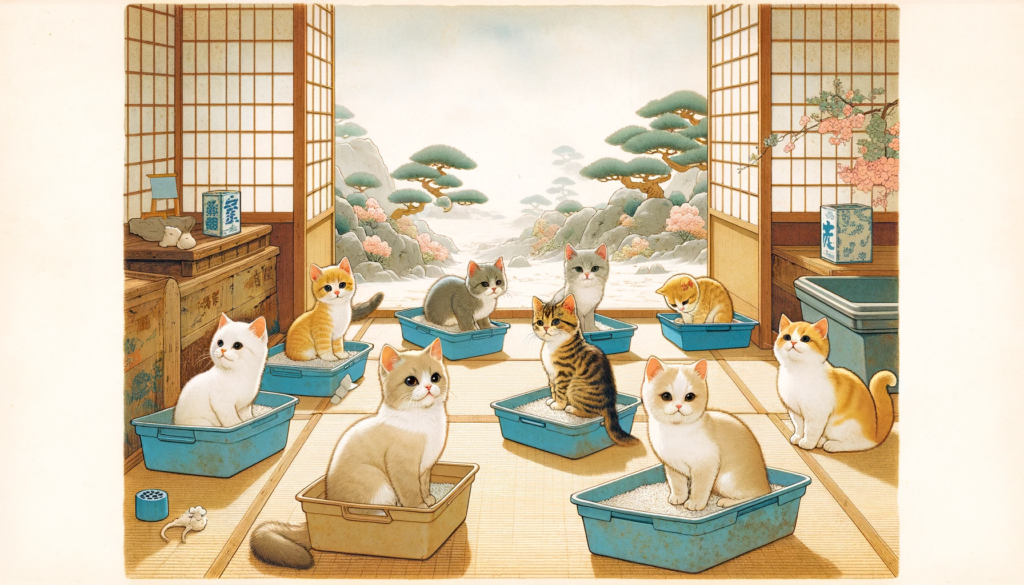The good news is, it’s never too late to litter train a cat! Whether you’re welcoming a kitten, an adult cat, or even a senior feline into your home, litter training is entirely possible. In fact, with a little patience and understanding of your cat’s needs, you can help them adjust to using the litter box at any age.
Key Takeaways
It’s Never Too Late: Regardless of your cat’s age—kitten, adult, or senior—it is always possible to litter train them with patience and the right approach.
Understand Your Cat: Factors like past experiences, health issues, or territorial behavior can affect your cat’s litter box use. Address these issues to make training easier.
Positive Reinforcement is Key: Reward your cat for using the litter box and avoid punishment for accidents to foster a stress-free environment.
Choose the Right Tools: Select a litter box and litter that suit your cat’s needs. Location and cleanliness of the litter box also play a vital role in successful training.
Consistency is Essential: Stick with the process, as some cats may take longer than others to adapt, but with patience, any cat can learn.

You May Also Like: Overcoming Litter Box Aversion: Essential Tips for Cat Owners
Can Older Cats Be Litter Trained?
Many cat owners assume that litter training is only for kittens, but this is far from the truth. Cats are creatures of habit, and while older cats may have established routines, they are also highly adaptable. This means that you can successfully litter train a cat, no matter their age.
Understanding Your Cat’s Behavior
It’s important to understand why a cat might struggle with using a litter box. There are a few factors that could affect this, such as:
- Past Experience: If your cat didn’t grow up using a litter box, they may be unfamiliar with it. Stray cats or older felines from shelters might need extra guidance.
- Health Issues: Sometimes, cats avoid the litter box due to health problems like urinary tract infections or arthritis, which makes it painful for them to use.
- Territorial Behavior: Cats are territorial animals, and introducing them to a new space can be overwhelming. They may avoid the litter box out of anxiety or stress.
If your cat is experiencing any of these issues, do your best to address them before starting litter training. A visit to the vet can help rule out any medical problems that could be contributing to litter box avoidance.
Step-by-Step Guide to Litter Training Your Cat
So, when is it too late to litter train a cat? The answer, as we’ve already mentioned, is never! Here’s a simple step-by-step guide to help you train your feline friend:
Choose the Right Litter Box and Location
Cats are particular about where they do their business, so it’s essential to pick a litter box that meets their needs. Look for a litter box that is large enough for your cat to comfortably turn around in. Older cats, especially, may need a box with low sides to easily step in and out.
Location matters too. Make sure the litter box is in a quiet, low-traffic area where your cat can feel safe. Placing the box in a secluded spot ensures your cat feels comfortable and isn’t startled by loud noises or other pets.
Use the Right Cat Litter
The type of litter you choose can make or break the litter training process. Cats can be picky about their litter, so it’s a good idea to experiment with different types. Some cats prefer unscented, fine-grained litter, while others may do well with clumping cat litter.
When introducing a new cat litter, it’s best to start with something that resembles the natural material your cat is used to (like dirt or sand). Once your cat is comfortable, you can gradually transition to your preferred litter type.
Encourage Positive Associations
Litter training is all about creating positive experiences around the litter box. If your cat uses the litter box, offer praise and rewards. Cats respond well to positive reinforcement, so giving them treats or extra affection when they use the box correctly helps reinforce the behavior.
If your cat has an accident outside of the litter box, it’s important not to scold or punish them. Cats don’t understand punishment in the way humans do, and this can create anxiety, making litter training even harder.
Address Accidents Quickly
Accidents happen, especially during the litter training process. If your cat misses the box, clean the area thoroughly with an enzymatic cleaner to remove any lingering scent. Cats are more likely to return to the same spot if they can still smell their previous accident.
It’s also a good idea to place the litter box in areas where accidents have occurred. This gives your cat a clear signal of where they should be going.
Be Patient and Consistent
Litter training takes time, especially for older cats who may be set in their ways. The key is to be consistent and patient. Keep the litter box clean, offer plenty of praise, and give your cat time to adjust.
Remember, every cat is different. Some may catch on in just a few days, while others might take a little longer. Stick with the process, and soon enough, your cat will be happily using the litter box.

Common Questions About Litter Training
Q: How long does it take to litter train an older cat?
A: The time it takes to litter train an older cat can vary. Some cats may take just a few days, while others might need a few weeks. Consistency and patience are key.
Q: What if my cat refuses to use the litter box?
A: If your cat is avoiding the litter box, it could be due to health issues, stress, or the wrong litter box setup. Make sure to rule out any medical problems and create a comfortable environment for your cat.
Q: Can I litter train a stray or outdoor cat?
A: Yes, even outdoor cats can be litter trained. Start by placing the litter box in a location that resembles where they’ve been going outside, and gradually transition them to using it indoors.
Q: Should I use covered or uncovered litter boxes?
A: This depends on your cat’s preferences. Some cats feel safer with covered boxes, while others may feel trapped. Experiment with both types to see which one your cat prefers.
Q: How do you teach a 2-year-old cat to use the litter box?
A: Introduce the litter box in a quiet, accessible place and gently guide your cat to it after meals and nap times. Use positive reinforcement like treats or praise when your cat uses the litter box correctly.
Q: Why is my 2-year-old cat not using the litter box anymore?
A: Your cat might be avoiding the litter box due to cleanliness issues, health problems, or stress. Check the box’s cleanliness, consult a vet, and ensure a stress-free environment to address this behavior.
Q: What’s up with my 14-year-old cat not using the litter box now?
A: Sudden changes in litter box habits in older cats can often be linked to health issues or discomfort due to aging. It’s important to consult a veterinarian to rule out any medical problems.
Q: Is it okay to put catnip in the litter box?
A: While catnip can attract cats to certain areas, it’s not typically recommended for litter boxes as it might confuse the purpose of the box. Instead, use catnip in play areas to keep the litter box solely for its intended use.
Q: Why isn’t my 13-year-old cat using the litter box anymore?
A: Changes in litter box usage by senior cats could be due to medical issues, discomfort, or the need for a more accessible litter box. Assess for any signs of illness, and consider a box with lower sides for easier access.
Conclusion
Litter training a cat is never an impossible task, no matter how old your feline friend may be. The key is to understand your cat’s behavior, create a comfortable environment, and be patient with the process. By following the steps outlined above, you can successfully litter train any cat, ensuring a cleaner and happier home for both you and your furry companion.
Further Reading
How To Litter Train An Older Cat (A Step-By-Step Guide)


